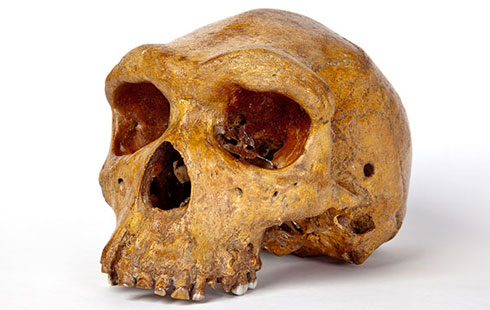Inside a small museum in East London is exhibited the replica skull of the first early human fossil discovered in Africa. Whoever the human was, he little knew that his remains would eventually cause a political controversy many centuries on between two governments. The skull from Broken Hill is one of the primary pieces
of evidence that supports Charles Darwin’s – albeit controversial – theory of evolution, mankind’s descent from primates; yet it, and the place where it was found are also a visceral part of modern day Zambia’s history, and the subject of an exhibition by Bangkok-based artist, Pratchaya Phinthong. The exhibition he says functions like a film, a fiction, something that has been told over time and it depends, if you believe it or not – it’s not a documentary, it’s something else,’ says Pratchaya Phinthong ‘.. It’s a complex of things that clash together – even the subject of where we come from – whether you really believe Darwin’s theory’. Kabwe, the place where the skull was found played a role in Zambia’s ‘Independence’; because of its central location and railway union base, it was chosen as the site for a rally held on October 26, 1958 at Mulungushi Rock north of the city, involving the Zambian African National Congress founded by Dr Kenneth Kaunda, who later became the first post-independence leader of Zambia. Not far from where that rally took place on 17th June 1921, alongside his African colleagues, Tom Zwiegler, a Swiss-born miner for the Rhodesia Broken Hill Mining Company, whilst exploring limestone at Kabwe (formerly Broken Hill) in Zambia stumbled upon a skull along with femur, tibia and humerous bones beside a pelvis. They could find no reason for the skull and bones being there.
A doctor from the Broken Hill Hospital, F Wallace, studied the skull. Unusually it had small broken teeth, large brioriges and no crown ridge. There is a hole in the left side, possibly suggesting a self-inflicted injury or the result of a disease. The jawbone was never discovered. Studies continue to this day as to why Broken Hill Man had broken teeth. The skull was later examined and labelled, ‘Homo rhodesiensis’ before being taken to the United Kingdom. A doctor from the Broken Hill Hospital, F Wallace, studied the skull. Unusually it had small broken teeth, large brioriges and no crown ridge. There is a hole in the left side, possibly suggesting a self-inflicted injury or the result of a disease. The jawbone was never discovered. Studies continue to this day as to why Broken Hill Man had broken teeth. A replica of the skull is on display in the Lusaka National Museum but the skull in the exhibition is an identical model purchased online by the Bangkok-based artist Pratchaya Phinthong.
On 30th April 1974 the now decade-old Republic of Zambia Government made a request for the skull and bones to be transported back to Lusaka. A week later, on 6th June, the then British Government responded that the original remains were a gift to the Natural History Museum from the late Mr.Ross. Yet the Zambians, under President Kenneth Kaunda, responded ‘How come many Africans can afford to travel to London to see the bones? Why can Europeans not travel to Zambia’ – ostensibly to see Broken Hill Man’s genuine skull, were the original to be returned there.
The Natural History Museum responded that Zambia’s climactic conditions were not good for preserving skulls. They claimed the skull and bones belonged to all mankind as Homo rhodesiensis, or Homo heidelbergensis, with its links to Neanderthal (European) Man and the Denisovans represents all our ancestors and not only to Africa. A replica of the skull is on display in the Lusaka National Museum but the skull in the exhibition is an identical model purchased online by the Bangkok-based artist Pratchaya Phinthong.
Today, a replica of the skull is on display in the Lusaka National Museum but the skull in the exhibition is an identical model purchased online by the Bangkok-based artist Pratchaya Phinthong. The display is his latest commission. Kamfwa Chishala, a guide at the Lusaka National Museum, has accompanied the exhibition, giving an account of the skull’s history to visitors. At London’s Chisenhale Gallery. Curiously the document on the wall facing the skull is an export licence obtained from the National Heritage Conservation Commission in Zambia, as even the replica is classified as a national relic. It is fixed there by two copper nails, copper being Zambia’s main export – what remains to be seen, and the haunting question of Phinthong’s work, is how permanent the location and ownership of Broken Hill Man’s skull will or should be.
Broken Hill is at Chisenhale Gallery until 1st September www.chisenhale.org.uk
Ashley Dickerson

